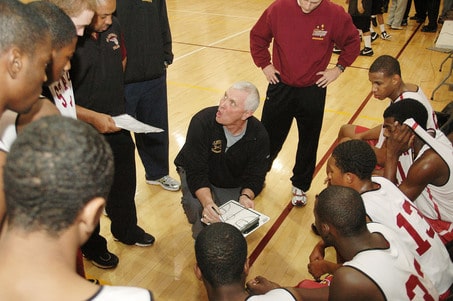
How to Manage and Utilize Bench Players Effectively: Maximizing Rotations, Maintaining Readiness, and Building Team-Wide Contribution
Effectively managing and utilizing bench players is crucial for a successful basketball program. Bench players often play a pivotal role in maintaining team performance throughout the game, contributing during crucial moments, and providing depth.
A well-rounded approach to bench management not only optimizes team performance but also fosters a positive environment for all players, ensuring that everyone feels valued and engaged.
Here’s a comprehensive guide on how to manage and utilize bench players effectively.

1. Understand the Importance of Bench Players
Support Team Depth
Bench players are essential for maintaining team energy and providing depth during games. Their contributions can have a significant impact on the team’s success over the course of a season.
- Versatility: Bench players often possess skills that can be deployed in various game situations, making them valuable assets.
- Game Management: A strong bench allows coaches to rotate players effectively, reducing the risk of injury and fatigue among starters. This is particularly important in high-stakes games where stamina can be a deciding factor.
Prevent Player Fatigue
Properly managing bench players helps prevent starters from becoming fatigued, ensuring that key players remain fresh and perform at their best during crucial moments.
- Energy Maintenance: Fresh legs can change the dynamic of the game. When starters are well-rested, they are more likely to execute plays effectively and make critical decisions in high-pressure situations.
- Strategic Rest: Rotating players strategically allows coaches to manage the physical toll of the game while maintaining competitive intensity.
Prepare for Injuries
Injuries are an unfortunate reality in sports. Bench players must be prepared to step into significant roles when starters are unavailable.
- Preparedness: Ensuring that bench players receive ample playing time during games helps them stay sharp and ready for unexpected opportunities.
- Next-Man-Up Mentality: Cultivating a culture where bench players are ready to contribute fosters resilience and adaptability within the team.

2. Develop a Rotation Plan
Creating a clear rotation plan helps manage bench players and ensures they contribute effectively.
Establish Roles
Define specific roles and responsibilities for each bench player, ensuring they understand how they fit into the team’s overall strategy.
- Skill Assessment: Assess the strengths and weaknesses of each bench player to tailor their roles accordingly. This may involve focusing on defensive capabilities, rebounding, or scoring.
- Clear Expectations: Communicate expectations regarding performance in practice and games to help players understand their contributions.
Set Rotation Patterns
Develop rotation patterns that allow bench players to receive regular playing time.
- Game Flow Consideration: Consider game flow, matchups, and player fatigue when determining when to rotate players. A flexible rotation strategy can help optimize team performance.
- Substitution Timing: Establish clear guidelines for when and how substitutions will occur during games, ensuring that all players are informed.
Adjust Based on Performance
Be flexible with your rotation plan based on player performance and game situations.
- Real-Time Adjustments: Monitor players’ performance closely during games and be willing to make real-time adjustments based on how players are executing their roles.
- Feedback Loops: After games, discuss performance with bench players to assess how they felt about their time on the court and what adjustments may be beneficial in future games.
3. Communicate Expectations Clearly
Effective communication is key to ensuring that bench players understand their role and responsibilities.
Set Clear Goals
Communicate specific goals and expectations for each bench player, ensuring they understand their contributions.
- Practice Engagement: Encourage bench players to approach practices with the same seriousness as starters, reinforcing that every practice counts toward their readiness.
- Team Goals: Share broader team goals and emphasize how each player contributes to achieving these objectives, promoting a sense of purpose.
Provide Feedback
Regularly provide constructive feedback to bench players on their performance.
- Positive Reinforcement: Celebrate small victories and improvements, which can motivate bench players to continue developing their skills.
- Actionable Critiques: Provide specific, actionable advice to help them improve. Focus on what they can do better in the next practice or game.
Encourage Open Dialogue
Foster an environment where bench players feel comfortable discussing their concerns and seeking advice.
- Team Meetings: Hold regular team meetings to discuss goals, strategies, and individual performances, allowing bench players to voice their thoughts.
- One-on-One Conversations: Offer opportunities for personal check-ins with players to provide support and discuss their experiences openly.

4. Focus on Development and Preparation
Investing in the development and preparation of bench players ensures they are ready to contribute effectively when called upon.
Provide Individual Training
Offer individual training sessions to help bench players improve their skills and overall game.
- Skill-Specific Drills: Design drills that focus on the specific skills that bench players need to develop, such as shooting accuracy or defensive footwork.
- Goal-Oriented Training: Create personalized development plans that include short-term and long-term goals for improvement.
Encourage Practice
Promote active participation in practice sessions, emphasizing the importance of preparation.
- Game-Like Situations: Incorporate drills that simulate game situations so that bench players can practice responding to real-time challenges.
- Intensity and Focus: Encourage bench players to maintain high intensity and focus during practices, reinforcing the importance of readiness.
Simulate Game Scenarios
Integrate game scenarios into practice to help bench players adapt to real-game conditions.
- Situational Drills: Use situational drills to replicate the pressure of critical game moments, allowing players to practice executing strategies under pressure.
- Role Play: Have players switch roles to understand different positions, enhancing their tactical awareness and adaptability.
5. Utilize Bench Players Strategically
Strategic utilization of bench players can make a significant difference in game outcomes.
Leverage Matchups
Use bench players to exploit specific matchups or weaknesses in the opponent’s lineup.
- Scouting Insights: Utilize insights from scouting reports to identify which opponents may struggle against particular skill sets.
- Strategic Substitutions: Make substitutions based on matchups during games, ensuring that players are positioned to take advantage of favorable conditions.
Impact Key Moments
Identify moments in the game where bench players can make a significant impact.
- Energy Boost: Utilize bench players to provide a spark of energy during lulls in the game, such as when starters show signs of fatigue.
- Defensive Stoppers: Deploy bench players who excel defensively to disrupt the opponent’s rhythm during critical stretches of the game.
Monitor Game Flow
Pay attention to the flow of the game and adjust the utilization of bench players accordingly.
- Momentum Changes: Recognize shifts in momentum and make timely substitutions to capitalize on or counteract those changes.
- Effective Timing: Ensure bench players are utilized at critical junctures in the game, maximizing their contributions when they can have the most impact.

6. Promote Team Chemistry and Morale
Maintaining team chemistry and morale is essential for bench players to stay engaged and motivated.
Foster Team Spirit
Encourage team bonding activities and positive interactions among bench players and starters.
- Team-Building Events: Organize team-building exercises, outings, or social events that strengthen relationships and promote a sense of belonging.
- Collaborative Goals: Set team goals that require contributions from both starters and bench players, reinforcing the idea that everyone plays a vital role.
Acknowledge Contributions
Recognize and appreciate the contributions of bench players, both in practice and during games.
- Public Recognition: Highlight the efforts of bench players in team meetings and after games, ensuring they feel valued.
- Celebrate Small Wins: Acknowledge their contributions during practices and scrimmages, even if they are not on the court during games.
Support Role Acceptance
Help bench players accept their roles and understand their importance to the team’s success.
- Role Clarity: Regularly discuss the significance of each player’s role, ensuring that bench players recognize how they fit into the larger picture.
- Encourage Positivity: Foster a positive mindset by emphasizing that every player has a unique role that contributes to the team’s success.

7. Review and Adjust Regularly
Regular review and adjustment of bench player management practices ensure continuous improvement.
Evaluate Performance
Regularly assess the performance of bench players and their impact on the team.
- Data Tracking: Utilize performance metrics to track contributions, such as points scored, defensive stops, and overall efficiency.
- Video Reviews: Analyze game footage to evaluate how bench players performed in their opportunities, providing specific feedback.
Adjust Strategies
Be willing to adjust your strategies based on evolving team needs and player development.
- Dynamic Adjustments: Stay flexible and make changes to your bench management strategies as the season progresses and players develop.
- Seasonal Reevaluation: Periodically reevaluate your approach to managing bench players, incorporating lessons learned and feedback received.
Seek Feedback
Gather feedback from bench players on their experiences and suggestions for improvement.
- Post-Game Discussions: Hold discussions with bench players after games to gain insights into their experiences and how they felt about their roles.
- Continuous Improvement: Create a culture where feedback is welcomed, allowing players to contribute to refining management practices.
How to Manage and Utilize Bench Players Effectively Conclusion:
Effectively managing and utilizing bench players involves understanding their importance, developing a clear rotation plan, communicating expectations, focusing on development, utilizing players strategically, promoting team chemistry, and reviewing practices regularly.
By following these guidelines, you can maximize the contributions of bench players and enhance your team’s overall performance.
A well-managed bench not only contributes to a team’s immediate success but also plays a crucial role in developing future starters and maintaining a strong team culture.
With a thoughtful approach to bench management, coaches can ensure that all players are engaged, prepared, and motivated to contribute to the team’s success.



